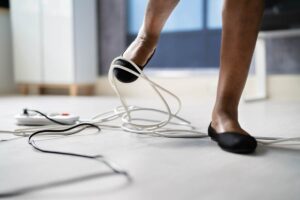From refrigerators to lights to computers — electricity is an integral part of our everyday lives. Just because it has become an ordinary part of our daily scenery, it does not mean we should overlook the importance of using it safely. May is National Electrical Safety Month and serves as a reminder to give your home an electrical checkup.
Outlets
Remember, the combination of electricity and water is dangerous. Make sure outlets in the kitchen, bathrooms, laundry, workshop, basement, garage or any area with access to water are equipped with ground fault circuit interrupters (GFCIs).
A GFCI monitors the flow of electricity in a circuit. If there is an irregularity, even a small one, the flow of electricity is shut off, preventing an electric shock. GFCIs should be tested monthly to ensure they are working properly.
If you have young children or pets at home, install tamper-resistant outlets (TROs) or cover unused outlets with plastic safety caps.
Never force plugs into outlets, and never remove the grounding pin (third prong) to make a three-prong plug fit a two-prong outlet. A two-prong outlet may not be grounded and should be updated and replaced by a qualified electrician. Additionally, avoid overloading outlets with adapters and too many appliance plugs.
It can be tempting to add just one more plug to that outlet or power strip, but adding one more electrical device just might overload the outlet and start a fire, so fight the urge to find ways to plug additional devices into an outlet. As an alternative, unplug a device before plugging in a new one.
Cords
Extension cords are designed for temporary use only. They should never be put in place as a long-term solution. A qualified electrician can help install the necessary wiring and outlets for a permanent solution.
As a safety precaution, make it a habit to remove a cord from the outlet by pulling on the plug rather than the cord itself. Make sure cords are not frayed or cracked, placed under carpets or rugs, or located in high-traffic areas. If a cord is damaged, replace it. Do not nail or staple them to walls, floors or other objects.
Wiring
Make sure fuses are properly sized for the circuit they are protecting. If you do not know the correct rating, have an electrician identify and label the correct size to be used. Always replace a fuse with one of the same size. Check to make sure circuit breakers are working properly.
If an appliance repeatedly blows a fuse, trips a circuit breaker or has given you an electrical shock, immediately unplug it and have it repaired or replaced. Look for cracks or damage in wiring and connectors and use surge protectors to protect electronics.
Check periodically for loose wall receptacles, wires or loose lighting fixtures. Listen for popping or sizzling sounds behind walls. Immediately shut off, then professionally replace light switches that are hot to the touch and lights that spark and flicker.
General home health
Be sure to upgrade incandescent or CFL light bulbs to LED ones, and remember that any type of appliance that uses electrical power can have an electrical failure or malfunction. Take steps in your home to minimize the risk.
As you continue to upgrade your home with more lighting, appliances and electronics, your home’s service capacity may become overburdened. If fuses blow or trip frequently, have a professional determine the appropriate service requirements for your home.
For more information on electrical safety, visit SafeElectricity.org.










